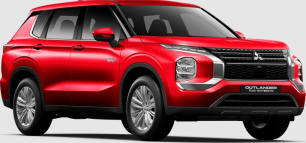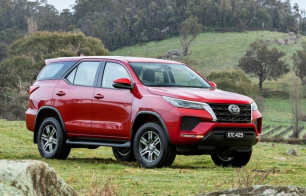As mentioned earlier, hybrids are your best buy at this moment in time, if you want to help save the world from climate-change disaster, avoid range anxiety, and save some money on fuel bills – all without having to sacrifice safety, comfort or features.
And – bonus – the Outlander is quite nice to drive. Not to mention a pretty handy light-duty off-roader. But more about that later.
It has a kerb weight of 2145kg with light but sharp steering and a tight (11.2m) turning circle so it’s an easy vehicle to manoeuvre around busy city and suburban streets.
The teaming of a 2.4-litre four-cylinder petrol engine and two electric motors works seamlessly well. There's always plenty of power on tap and, no matter how energetic your driving becomes, this Outlander remains smooth and quiet.
Throttle response is sharp and there’s plenty of punch off the mark as well as zippiness around town when you need it.
The PHEV’s EV-only driving range is a listed 84km but our test vehicle chewed through most of its battery power on a 110km highway trip through hilly territory.
Regenerative braking regained very little of that used power and the Outlander switched to rely on petrol for the remaining 30km or so of that trip.
The driver is able to adjust the degree of regenerative braking via paddle shifters on the back of the steering wheel: use the left to add more and the right to ease up.
The drive mode options tweak engine, electric motor, transmission and other factors to suit the selected set-up.
Other than that, ride is quite firm, handling is civilised and, overall, this Outlander is rather pleasant on sealed surfaces.
And, as I alluded to earlier, it’s surprisingly comfortable and capable off-road – as long as you stick within the parameters of the kind of 'off-road' terrain an AWD SUV is built to cope with: well-maintained gravel roads and dirt tracks with minor corrugations in dry conditions… or, at worst, rain-puddled blacktop.
The Outlander has satisfactory off-road measures for a city-focussed vehicle: of 18.3 degrees (approach angle), 22.2 degrees (departure), 18 degrees (ramp breakover) and 203mm of ground clearance (unladen).
It feels nimble in the bush because steering is light and precise, visibility is good all-around, and the vehicle settles well on gravel and dirt tracks at speed, only ever skipping around a bit on rougher sections, due to its firm suspension and road tyres.
You can switch drives modes to either Gravel, Snow or Mud to best suit the terrain on which you’re driving but with the Outlander’s lack of ground clearance, road-biased tyres and 20-inch wheels, this SUV is hamstrung by its city-biased physicality.
But, this is still a handy dirt-road tourer, yielding comfortable and controlled ride and handling, only ever becoming rattled when the road or track surface becomes very chopped up and bumpy.
The Outlander’s 'Super-All Wheel Control' (S-AWC) system deserves a fair amount of credit. This traction control system manages torque application so it is instantaneous, and delivers drive with impressive levels of throttle control and an even-handed management of power.
Worth noting the Outlander did, of course, go through battery capacity at a faster pace off-road than it did when we were on sealed surfaces .
Off-roading, by its very nature, is more difficult and demands more of a vehicle than driving on smooth sealed surfaces does. And, for that reason – and the fact the Outlander is quite low – I’d avoid driving this SUV on terrain more challenging than well-maintained gravel roads and dirt tracks with minor corrugations in dry conditions.
I’ve driven an Outlander PHEV on sand before and it taxes the capacity even faster.
As mentioned earlier, this Outlander does not have a spare tyre. The absence of a spare – even a space-saver – is a disappointment, especially if you’re considering using your PHEV as a touring vehicle. A puncture repair kit is provided.
Payload is listed as 605kg, towing capacity is 750kg for an unbraked trailer and 1600kg braked. GVM is 2750kg and GCM is 4350kg.






.png)



















































.png)























 copy.png)
















